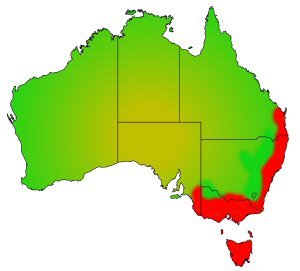Short Finned Eel
|
|
 Click to enlarge David Paul Museums Victoria / CC BY-NC - License / Source Click to enlarge David Paul Museums Victoria / CC BY-NC - License / Source |
Scientific Name
Anguilla australis
Other Common Names
Eel, silver eel, yellow eel
Size
To greater than 1m, 3Kg
Conservation Status
Common, widespread
Habitat
Often preferring still waters such as lakes, dams and swamps, nevertheless often quite abundant in rivers and streams, especially in areas of lower water velocity. Found in a wide range of habitats throughout it range.
 Distribution
Distribution
Widespread and common in coastal river systems in southern Queensland, New South Wales, Victoria, Tasmania and the larger Bass Straight islands. Considered rare in South Australia. Also widespread in the south-western Pacific, for example New Zealand, Norfolk, Lord Howe and Chatham Islands as well as Fiji and Tahiti.
Reproduction
Short finned eels have an interesting life-cycle. The mature adults migrate from fresh water to the sea in order to spawn after which it is believed they die. Where they actually spawn is uncertain but is believed to be in the South Coral Sea off the coast of North Queensland. Mature females about a metre in length have been found to contain more than 3 million eggs.
The eel larvae, known as leptocephali because of their leaf like flat shape, are carried south by the East Australian Current from their spawning grounds until they reach the continental shelf. At around this time they metamorphose into the normal tubular eel shape although devoid of any pigment and so are known as glass eels.
When the glass eels begin to migrate into fresh water they may be anywhere from one to three years old. Migration begins in the autumn in Northern regions reaching Western Victoria by mid spring. Whilst in the estuarine waters the glass eels quickly develop into fully pigment elvers and adjust to fresh water.
Subsequent migrations from the estuaries into fresh water involve both elvers and glass eels and may happen after, during or before the main migration from the sea. These migrations are know as "eel fares" from which the term "elver" is derived. Generally these occur at night and may involve as many as four different age classes.
The upstream migration continues well into the upper reaches of the river systems and elvers and glass eels (and adults) can overcome even large obstructions such as dams and waterfalls by the simple expedient of traveling overland in damp conditions, with a motion much like snakes.
Eels can live for a long time and females may reach the age of 35 years before feeling the urge to begin the cycle all over again. Males may live for 25 years. However females as young as 10 and males as young 6 may begin the downstream migration to breed.
Diet
Opportunistic, mainly carnivorous feeders, eels eat all manner of aquatic animals including fish, insects, yabbies, shrimps, molluscs and frogs.
Angling
Eels readily take bait, often that intended for other species. Can provide good fun on light tackle. Not generally deliberately fished for by freshwater anglers and often despised for their snake like appearance and heavy slime coating.
On the table
If caught in clear water, eels provide good eating. Generally prepared by skinning and cutting into suitable lengths. Unlike many fish, eel is quite good if well pan fried over a moderate to high heat until the flesh begins to brown. Smoked eel is delicious.
In the aquarium
Eels make interesting pets, but some individuals can be terrible escapologists. Easy to feed, eels will take a wide variety of food, such as fish strips and live shrimp, yabbies and aquatic insects.